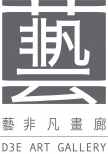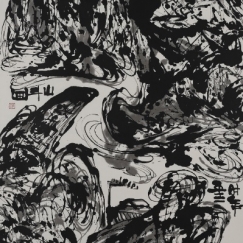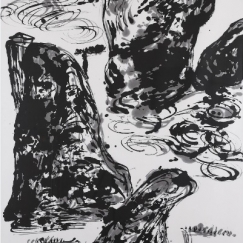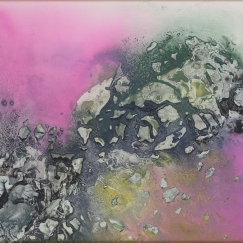Wesley, with his family’s roots in Zhongshan, Guangdong Province, was born in Hong Kong in 1957. From 1963-1969, Wesley attended St. Paul’s Co-educational College Primary School, and from 1969-72 attended St. Paul’s Co-educational College.
He was 15 when he was diagnosed with schizophrenia, a condition that together with a fervent commitment to Zen philosophy shaped his bold artistic vision and his life. At 17, while still a student at Hong Kong International School (HKIS), Wesley commenced to formally paint, at first in a manner inspired by the Chinese literati style, wenren hua.
Following graduation from HKIS in 1977, Wesley moved to Toronto, Canada, where he studied Western painting at Ontario College of Art and Chinese brush painting with the renowned Madame Koo Tsin-yaw (Gu Qingyao, 1896-1978).
It was at this time that Wesley also began to explore and to teach himself splash-ink painting, a technique which originated in 8th century China and was exemplified by the work of Zhang Daqian in the mid-20th — and for which, eventually, Wesley would himself become best known.
Wesley returned home to Hong Kong in 1981, where he continued his studies with Harold Wong (Huang Zhongfang, b. 1943 ), the distinguished collector, connoisseur and painter. In the ensuing decade, Wesley continued to explore the creative possibilities of splash-ink painting and began to draw on his Western and Eastern influences for the creation of highly original contemporary works. During the latter half of the 1980s these early works were shown in several one-man exhibitions and in the 1988 group show, Modern Chinese Paintings by Five Artists, at Hong Kong’s City Hall.
Throughout his career, Wesley considered landscape painting to be the most difficult and highest accomplishment of Chinese art and devoted most of his energies to mastering the form, in particular mountain-scapes. Indeed, in the 1990s he often referred to himself as “Mountainscape Teacher “(Shandou Laoshi) and, in his later years signed his paintings as “Mountain Taoist” (Shandou Daoren). Wesley also excelled in painting bamboo, plum blossoms, lotus, orchids and pines, and was a highly accomplished calligrapher, as well.
Throughout the 1990s and into the new millennium, Wesley intensified his commitment to splash-ink painting. His spiritual journey towards Zen-based enlightenment was by this time inseparable from his artistic explorations — transcending the conventional bounds of landscape painting was akin to transcending one’s self. Wesley referred to his works during this period as Mountains of Heaven Zen paintings, and attributed their remarkable, meditative imagery to a pure state of mind, describing them as flowing from a world beyond and emanating from the artist’s heart.
At the same time, Wesley continued to be inspired by Western art. Indeed, the strong colors in his work may have been directly influenced by his studies of Western art. In particular he admired cubism for the way in which it brought volume into painting, and among Western painters he clearly favored Picasso, whose creativity he revered.
Wesley’s work was shown to acclaim at one-man exhibitions in Hong Kong, the United Kingdom and the United States throughout the 1990s and at the group shows New Trends – Art Hong Kong in 1994 and Art Asia in 1995.
Wesley continued to form his own style of Chinese landscape art and to break from the traditional forms of Chinese landscape painting. From the late 1990s onwards, he explored ways of integrating his splash-ink methods with traditional Chinese brushstroke techniques. Beginning in 2001, he also experimented with finger painting. He may well have used his fingers to subtly manipulate ink in his splash-ink landscapes before then, but over the next decade, he worked increasingly with fingers and nails. By 2009, he had virtually ceased using brushes, working primarily with fingers and nails.
Throughout his all-too-brief, intensely experienced life, Wesley struggled with schizophrenia while bravely countering his afflictions through his art. This constant creative tension, a source of true happiness for him, left us with a unique artistic legacy that realized a tranquil, enlightened, unspoilt natural world in stark contrast to the private, painful world in which he lived. His works are in public and private collections in Australia, Canada, China, Hong Kong, Japan, Korea, Singapore, Taiwan, Thailand, United Kingdom and United States.
Wesley passed away on July 16th, 2012.
Solo Exhibitions
| 2014 | Ink Explorations: A Wesley Tongson Restrospective, Hong Kong Arts Centre, Hong Kong |
| 1995 | Solo exhibition, Hong Kong American Club, Hong KongSolo exhibition, Mandarin Oriental Fine Arts, Hong KongSolo exhibition, Godfrey Far Eastern Art, London, UKTongson 10th Anniversary Exhibition, “Wesley Tongson”, Hong Kong City Hall, Hong Kong |
| 1994 | The Vibrant Land, Artpreciation Gallery, Hong Kong |
| 1993 | Mountains of Heaven – Modern Chinese Paintings by Tong Kai Wai, Pacific Asia Museum, Pasadena, California, US |
| 1992 | Mountains of Heaven – Modern Chinese Paintings by Tong Kai Wai, Hong Kong Arts Centre, Hong Kong |
| 1991 | Dancing Colours – Paintings by Wesley Tongson, Hong Kong Arts Centre, Hong Kong |
| 1990 | Solo exhibition, Ngau Chi Wan Civic Centre, Hong Kong, sponsored by Hong Kong Urban Council |
| 1989 | The Exhibition of Wesley Tongson, Hanart 2 Gallery, Hong Kong |
| 1988 | Solo exhibition, Hong Kong Arts Centre, Hong Kong |
| 1986 | Solo exhibition, Galerie du Monde, Hong Kong |
| 1985 | First solo exhibition, Hong Kong City Hall, Hong Kong |
Group Exhibitions
| 1995 | Group exhibition, Art Asia, Hong Kong Convention and Exhibition Centre, Hong Kong |
| 1994 | New Trends – Art Hong Kong, Hong Kong Convention and Exhibition Centre, Hong Kong |
| 1988 | Modern Chinese Paintings by Five Artists, Hong Kong City Hall, Hong Kong |
-
Hong Kong Museum of Art
-
Hong Kong Art School
-
Morgan Stanley Asia Limited
-
First Eastern Investment Group (Hong Kong & Shanghai)
-
Four Seasons Hotel Hong Kong
-
Conrad Hong Kong Hotel
-
Conrad Tokyo Hotel
Publications
| 1996 | The landscape – Modern Chinese Paintings by Tang Jiawel, Hong Kong |
| 1994 | The Landscape – Modern Chinese Paintings by Tang Jiawel, Hong Kong |







